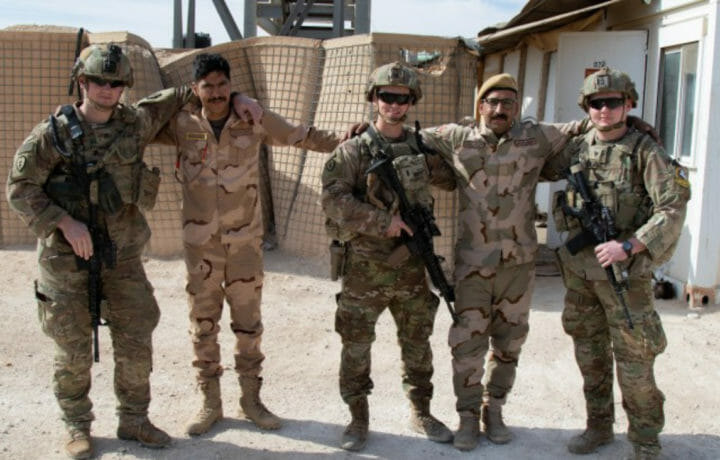The total U.S. withdrawal from Afghanistan last summer led to a swift—and equally total—collapse of the Afghan government to the Taliban. U.S. forces have been simultaneously drawing down their presence in Iraq this year. But there will be no full Iraq withdrawal. Around 2,500 troops remain, and U.S. defense officials said this month that this force will stay. Its mission: advise and assist Iraq’s national forces against the Islamic State (IS), and—ultimately—ensure that Iraq doesn’t become another Afghanistan.
“We’ve drawn down from bases we didn’t need, we’ve made it harder to get at us. But the Iraqis still want us to be there. They still want the presence, they still want the engagement,” said Marine General Frank McKenzie, top U.S. commander for the Middle East. “So as long as they want it, and we can mutually agree that’s the case—we’re going to be there.”
IS no longer controls vast swaths of Iraqi territory, but the notorious terrorist army is still active and causing havoc in parts of the country. It’s actually stepped up its activity in the past few months, such as a complete armed takeover of Luhaiban, a village in the Kirkuk province.
General McKenzie predicted that IS will “keep recreating itself” and that the United States and allies will have to work together to make sure that IS doesn’t link up with other terrorist groups and become an international menace all over again.
The Beginning of the End of the Combat Mission
Over the last few years, U.S. and international coalition partners have been incrementally handing over responsibility for Iraq’s defense to the Iraqis. The process moved forward in July, when President Biden and Iraqi Prime Minister Mustafa al-Kadhimi met to formally bring the U.S. combat in Iraq mission to an end this year. The two men issued a joint statement announcing that “there will be no U.S. forces with a combat role in Iraq by Dec. 31, 2021.”
U.S. forces reached this benchmark a few weeks early: On December 9, Iraqi national security adviser Qasim al-Araji announced that all remaining U.S. troops have transitioned from a combat role to a role of “advise, assist, and enable.” This pared-down role consists of training Iraqi troops, gathering intelligence on ISIS forces, and providing occasional air support. And no more direct combat; that’s the job of Iraqi troops and Kurdish militias now.
U.S. forces have fully withdrawn from eight bases since July. And in November, a command post was moved from a U.S. installation in Kuwait to an Iraqi one in Iraq. U.S. forces also recently handed 2,000 military vehicles over to the Iraqi military. And according to a U.S. military report, out of 426 anti-IS operations that Iraqi counterterrorism forces carried out from July-September, coalition troops joined them on only 13.
But the Iraqi military can’t do it all singlehandedly just yet. An Iraqi government official told Deutsche Welle, off the record, that the Iraqi military still needs “U.S. intelligence on the IS terrorists.” He also said that Iraq’s air force is “comparatively weak” and not yet ready to stand on its own.
“We still need U.S. forces here, particularly when it comes to air cover and combat aircraft,” the source said. “If it wasn’t for the U.S. Air Force, the country would be far more vulnerable to external drone attacks, and it would also have difficulty mounting aerial attacks on the IS group.”
Still in the Line of Fire
The end of combat doesn’t mean that U.S. troops are no longer in harm’s way, however. The Popular Mobilization Forces (PMF), Iran-backed militias that oppose any U.S. presence in the country, have launched numerous rocket and drone attacks on U.S. forces. One PMF missile barrage in early 2020, on the al-Asad airbase where U.S. troops were stationed, caused traumatic brain injuries to more than a hundred U.S. personnel.
As long as U.S. troops are still in-country, more PMF attacks are a near-certainty.
“They actually want all U.S. forces to leave, and all U.S. forces are not going to leave… That may provoke a response,” said General McKenzie.
These groups might up their capacities to attack, via heavier weaponry courtesy of Iran. General McKenzie voiced concern over Iran’s ongoing development of ballistic missiles, cruise missiles, and armed drones—and warned that Iran would have no qualms about sending weapons such as these to its Iraq-based proxies.
“Iran still pursues a vision of ejecting us,” he said. “And they see the principal battleground for that as being in Iraq. And I believe they are under the view that they can increase friction in Iraq to where we will leave.”
Keeping the Peace, While Preparing for War
After World War II, the United States established a permanent presence in Europe and Japan in hopes of discouraging regional bad guys from starting the next war. Another permanent U.S. presence formed in South Korea, after the Korean War, to discourage North Korea from planning another invasion. All these zones have been (mostly) peaceful to the present day.
But whereas postwar Germany or South Korea were genuinely postwar—no more bullets, no more tanks—there is no such peace on the ground in Iraq. Violence continues, and the perpetrators of that violence see no reason to quit. Which means that U.S. troops will deploy to Iraq with the knowledge that they are heading into danger, and they might not come back.
Full-scale U.S. involvement in Iraq is history, and the high body counts of years past are history. But present U.S. military leaders and their troops will have to be on their guard, now and in the future.



